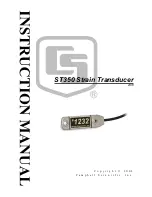
56
2.2.6
WIRING CABLE INSTALLATION
After installing the ELT Main Unit, Antenna and Remote Unit in the aircraft, install
the Coaxial Cable between the ELT Main Unit and the Antenna. The Cable should
not cross any production break and must have a reasonable amount of slack at the
ELT Main Unit. This slack is necessary to allow for easy removal of the Coax Cable
during maintenance and when needed as a Portable Device. If a longer Coaxial Cable
than the one supplied with the unit (6 feet), it may be fabricated using RG-142(MIL-
C-17) Cable and AMP 227079-5 Connectors or King KC-59-162 BNC Connectors or
their equivalent. Insertion Loss of the Cable should not exceed 0.8 dBm. Secure the
Coaxial Cable using Tie Wraps or other appropriate methods. Make sure the Cable is
protected from abrasion. RG 400/U or equivalent is acceptable.
The Remote Switch Unit is connected to the ELT Main Unit via means of RJ-12
Standard Type Modular Connectors. The RJ-12 Connecting Cable is included with
each ELT. To install the Cable, connect each modular plug at end of the
Interconnecting Cable to the ELT Main Unit Jack and the ELT Remote Switch Unit
Jack via T-Adapter Connector. (See Figures 14.1, 14.1.1)
Connect buzzer wiring and GPS wiring harness assembly P/N 4510042 to the ELT
Remote Switch Unit via T-Adapter Connector as well. (See Fig. 14.1, 14.1.1, 14.1.2,
and 14.2).
Note: All wiring harness assemblies (P/N 4510041/4510042) were Qualification
tested, including Flame Test per TSO C126/RTCA DO-204 requirements.
Avoid running this cable near sources of strong EMI/RFI radiation. Secure the Cable
along its run with Tie wraps or other suitable methods. The interconnecting cable
may be shortened or a longer cable of up to 200 feet may be used if required. Wiring
per M22759/18 or /35 (24 AWG) or equivalent is acceptable.
2.3
ELECTRICAL INSTALLATION
Please refer to FAA AC 43.13 for guideline.
Since both the ELT Main Unit and the Remote Unit have their own internal batteries,
there is no electrical connection required between the entire ELT system and the
Aircraft Electrical Power System. The audible buzzer is powered by the Remote Unit
internal battery.
2.4
POST INSTALLATION TEST
Please refer to FAA AC 43.13 for guideline.
After completing the mechanical installation,
ensure the ELT Main Unit must be
mounted with the FORWARD arrow marking adhered.
The following Post
Installation Function Tests must be performed. Regulations require that Transmitter
Tests only be done during the first 5 minutes of each hour. If you are at a location
where there is an FAA Control Tower or other monitoring facility, notify the facility
before beginning the tests.
Note: Press
RESET
anytime to turn off unwanted transmission.
Summary of Contents for AK-451 Series
Page 23: ...23 Figure A Front view of ELT Figure B 3 D view of ELT ...
Page 32: ...32 Figure 3 Mounting Tray with Clamp Holder for ELT AF AP ...
Page 37: ...37 Figure 6 Whip Antenna Model AK 451 017 1B ...
Page 39: ...39 Figure 2 1 2 ELT with mounting tray holder and adapter tray ...
Page 42: ...42 Figure 7 1 Rod Antenna AK 451 017 2A 1 ...
Page 45: ...45 Figure 8 Blade Antenna AK 451 017 3A ...
Page 48: ...48 ...
Page 51: ...51 Figure 11 Remote Audio Buzzer Monitor P N 451018 ...
Page 79: ...79 Figure 18 ELT Front Panels Main Unit and Remote Unit ...
Page 84: ...84 ELT S Top Label Figure 19 Automatic Portable ELT AP with integral antenna Survival ELT S ...
Page 108: ...108 ...
Page 109: ...109 ...
Page 110: ...110 ...
Page 111: ...111 ...
Page 112: ...112 ...
Page 113: ...113 ...
Page 114: ...114 ...
Page 127: ...127 ...
Page 128: ...128 ...
Page 138: ...138 Table 1 List of all available Protocols ELT Non Location Protocols ...
Page 139: ...139 ELT Location Protocols User Location Protocols ...
Page 151: ...151 ...
Page 152: ...152 ...
Page 153: ...153 ...
Page 154: ...154 ...
Page 155: ...155 ...
Page 156: ...156 ...
Page 157: ...157 ...
Page 158: ...158 ...
Page 159: ...159 ...
Page 160: ...160 ...
Page 161: ...161 ...
Page 162: ...162 ...
Page 163: ...163 ...
Page 164: ...164 ...
Page 165: ...165 ...
Page 166: ...166 ...
Page 167: ...167 ...
Page 168: ...168 ...
Page 169: ...169 ...
Page 170: ...170 ...
Page 171: ...171 ...
Page 172: ...172 ...
Page 173: ...173 ...
Page 174: ...174 ...
Page 175: ...175 ...
Page 176: ...176 ...
Page 177: ...177 ...
Page 178: ...178 ...
Page 179: ...179 ...
Page 180: ...180 ...
Page 181: ...181 ...
Page 182: ...182 ...
Page 183: ...183 ...
Page 184: ...184 ...
Page 185: ...185 ...
Page 186: ...186 ...
Page 187: ...187 ...
Page 188: ...188 ...
Page 189: ...189 ...
Page 190: ...190 ...
Page 191: ...191 ...
Page 192: ...192 ...
Page 193: ...193 ...
Page 194: ...194 ...
Page 195: ...195 ...
Page 196: ...196 ...
Page 197: ...197 ...
Page 198: ...198 ...
Page 199: ...199 ...
Page 200: ...200 ...
Page 201: ...201 ...
Page 202: ...202 ...
Page 203: ...203 ...
Page 204: ...204 ...
Page 205: ...205 ...
Page 206: ...206 ...
Page 207: ...207 ...
Page 208: ...208 ...
Page 209: ...209 ...
Page 210: ...210 ...
Page 211: ...211 ...
Page 212: ...212 ...
Page 213: ...213 ...
Page 214: ...214 ...
Page 215: ...215 ...
Page 216: ...216 ...
Page 217: ...217 ...
Page 218: ...218 ...
Page 219: ...219 ...
Page 220: ...220 ...
Page 223: ...223 Japan Civil Aviation Board Approval ...
Page 225: ...225 ...
Page 226: ...226 This page is left blank on purpose ...
Page 227: ...227 ...
Page 228: ...228 ...
Page 229: ...229 ...
Page 230: ...230 APPENDIX K MATERIAL SAFETY DATA SHEET FOR BATTERY ...
Page 231: ...231 ...
Page 232: ...232 ...
Page 233: ...233 ...
Page 234: ...234 ...
Page 235: ...235 ...
Page 236: ...236 ...
Page 237: ...237 ...
Page 238: ...238 ...
Page 239: ...239 ...
Page 240: ...240 ...
Page 241: ...241 ...
















































